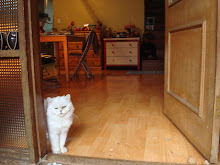This Korean magpie is a resident here for some years - same tree, same nest and the same places where she chills out!
They have their own ways to enjoy the season, the snow in particular and no doubt that on and off we the students have picked up frozen magpies and pigeons and brought them inside our rooms and they were ready to fly in the open skies and leave us as soon as they saw themselves among us inside these huge cages (our rooms).
In the West magpies bring bad luck but in Asia it brings the good news and for Chinese it's the 'Bird of Joy'. A chattering magpie symbolizes the coming of a guest or something good is going to happen. Actually in India and Pakistan, a crow symbolizes the same features and magpies belong to crow family...
In old Korean folk paintings (민화) we have often seen magpies chirping on a pine tree and under the tree is a crouching tiger. Daily Korean Stuff wrote:
Some of these painting are:The Tiger and Magpie paintings belong to the genre of Folk Art, as such, little is known about the authors of most of these paintings. The paintings were usually hung on the wall during the New Year ceremonies for about a month before being replaced by other pictures or calligraphies. Most of the paintings depict the same scene with a tiger crouching below a pine tree on which two magpies are chirping. Drawing on Chinese symbols, the Korean considered the magpie a bearer of good news. The tiger symbolized strength and power while the pinetree symbolized the upcoming year. It was therefore believed that if the painting was hung on New Year's, good news would be announced during the upcoming year.
Most of the paintings have a clearly humourous tone, which can be seen in the strange expression of the tiger's face.

















